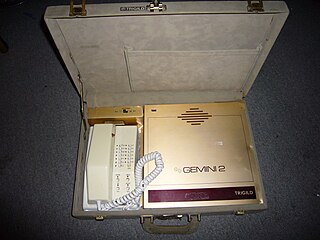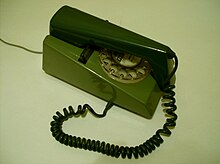
A telephone, colloquially referred to as a phone, is a telecommunications device that permits two or more users to conduct a conversation when they are too far apart to be easily heard directly. A telephone converts sound, typically and most efficiently the human voice, into electronic signals that are transmitted via cables and other communication channels to another telephone which reproduces the sound to the receiving user. The term is derived from Ancient Greek: τῆλε, romanized: tēle, lit. 'far' and φωνή, together meaning distant voice.

In telecommunications, an acoustic coupler is an interface device for coupling electrical signals by acoustical means—usually into and out of a telephone.

Pulse dialing is a signaling technology in telecommunications in which a direct current local loop circuit is interrupted according to a defined coding system for each signal transmitted, usually a digit. This lends the method the often used name loop disconnect dialing. In the most common variant of pulse dialing, decadic dialing, each of the ten Arabic numerals are encoded in a sequence of up to ten pulses. The most common version decodes the digits 1 through 9, as one to nine pulses, respectively, and the digit 0 as ten pulses. Historically, the most common device to produce such pulse trains is the rotary dial of the telephone, lending the technology another name, rotary dialing.

A hybrid transformer is a type of directional coupler which is designed to be configured as a circuit having four ports that are conjugate in pairs, implemented using one or more transformers. It is a particular case of the more general concept of a hybrid coupler.
In telephony, ringdown is a method of signaling an operator in which telephone ringing current is sent over the line to operate a lamp or cause the operation of a self-locking relay known as a drop.
In telephony, single-frequency signaling is line signaling in which dial pulses or supervisory signals are conveyed by a single-frequency tone in each direction in the voice-band. SF and similar systems were used in 20th-century carrier systems.
A busy signal in telephony is an audible call-progress tone or audible signal to the calling party that indicates failure to complete the requested connection of that particular telephone call.

A telephone call or telephone conversation, also known as a phone call or voice call, is a connection over a telephone network between the called party and the calling party. Telephone calls started in the late 19th century. As technology has improved, a majority of telephone calls are made over a cellular network through mobile phones or over the internet with Voice over IP. Telephone calls are typically used for real-time conversation between two or more parties, especially when the parties cannot meet in person.

The Improved Mobile Telephone Service (IMTS) was a pre-cellular VHF/UHF radio system which linked to the public telephone network. IMTS was the radiotelephone equivalent of land dial phone service. Introduced in 1964, it replaced Mobile Telephone Service (MTS) and improved on most MTS systems by offering direct-dial rather than connections through a live operator, and full-duplex operation so both parties could talk at the same time.

On analog telephone lines with special services, a flash or register-recall signal is used to control functions on the public telephone exchange, PBX or VoIP ATA.
The off-hook tone is a telephony signal for alerting a user that the telephone has been left off-hook without use for an extended period, effectively disabling the telephone line.
Loop start is a telecommunications supervisory protocol between a central office or private branch exchange (PBX) and a subscriber telephone or other terminal for the purpose of starting and terminating a telephone call. It is the simplest of the telephone signaling systems, and uses the presence or absence of loop current to indicate the off-hook and on-hook loop states, respectively. It is used primarily for subscriber line signaling. An extension of the protocol that adds disconnect supervision is often called kewlstart.
In telephony, ground start is a method of signaling from a terminal of a subscriber local loop to a telephone exchange, where one side of a cable pair is temporarily grounded to request dial tone. Most middle 20th-century American payphones used coin-first ground start lines, with the starting ground connection provided by the coin itself, bridging a set of contacts as it passed through the coin chute.
In telecommunication, supervision is the monitoring of a telecommunication circuit for telephony to convey to an operator, user, or a switching system, information about the operational state of the circuit. The typical operational states of trunks and lines are the idle and busy states, seizure, and disconnect. The states are indicated by various electrical signals and electrical conditions depending on the type of circuit, the type of terminating equipment, and the type of intended service.
The General Post Office (GPO) of the United Kingdom carried the sole responsibility for providing telecommunication services across the country with the exception of Hull. The GPO issued a range of telephone instruments to telephone service subscribers that were matched in function and performance to its telephone exchanges.

A headset is a combination of headphone and microphone. Headsets connect over a telephone or to a computer, allowing the user to speak and listen while keeping both hands free. They are commonly used in customer service and technical support centers, where employees can converse with customers while typing information into a computer. They are also common among computer gamers and let them talk with each other and hear others while using their keyboards and mice to play the game.

The candlestick telephone is a style of telephone that was common from the late 1890s to the 1940s. A candlestick telephone is also often referred to as a desk stand, an upright, or a stick phone. Candlestick telephones featured a mouthpiece (transmitter) mounted at the top of the stand, and a receiver (earphone) that was held by the user to the ear during a call. When the telephone was not in use, the receiver rested in the fork of the switch hook protruding to the side of the stand, thereby disconnecting the audio circuit from the telephone network.
Ringing is a telecommunication signal that causes a bell or other device to alert a telephone subscriber to an incoming telephone call. Historically, this entailed sending a high-voltage alternating current over the telephone line to a customer station which contained an electromagnetic bell. It is therefore also commonly referred to as power ringing, to distinguish it from another signal, audible ringing, or ringing tone, which is sent to the originating caller to indicate that the destination telephone is in fact ringing.

A telephone exchange, also known as a telephone switch or central office, is a crucial component in the public switched telephone network (PSTN) or large enterprise telecommunications systems. It facilitates the interconnection of telephone subscriber lines or digital system virtual circuits, enabling telephone calls between subscribers.

The Western Electric hand telephone sets are a series of telephones that were produced from 1927 by the Western Electric Company for the American Telephone and Telegraph Company (AT&T) and the Bell System. The series features the mouthpiece (transmitter) and the earpiece (receiver) combined into a hand-held unit, originally named a hand telephone, or handset. The handset would be held against the ear and in front of the mouth simultaneously, in contrast to earlier telephones in the Bell System where only the receiver was held against the ear, while the user spoke into a fixed transmitter mounted on a telephone stand or wall telephone.












